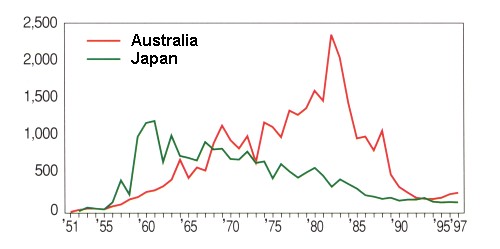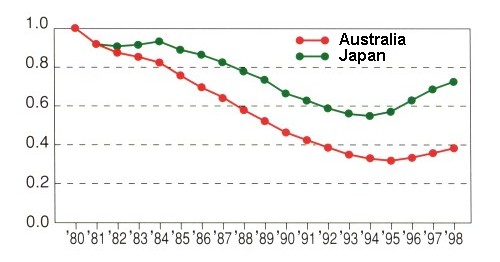- When total quota was 40,000 tons in early 1980s, Australian round
haul netter took many young (0 to 2 years old, less than 10kg weight)
tunas to produce canned tuna meat and it accelerated depletion of
southern bluefin tuna stock.
In fact, while quota in tonnage was less than Japan, taking of
young tunas by Australia resulted in taking much more number of
tunas than Japan (see the graph below, where red curve is Australia
and green one is Japan, unit of Y-axis is 1000).

Japan then gave financial and technical aid to Australian
fishery industry to reduce their catch of young tunas,
while accepting to reduce its quota from 23,150 to 6,065
tons, i.e. to 1/4.
- Since 1989 the total catch of southern bluefin tuna had been fixed
to 11,750 tons where Japanese share was 6,065 tons.
Different from whales which bear only one baby in every few
years, fish bear many eggs (for example, the number of eggs
which bluefin tuna bear at a time is 10 million) and speed of
recovery is faster.
In fact recovery of young southern bluefin tunas was verified and
CPUE (Catch Per Unit Effort) increased since early 1990s.
- When Japan accepted to reduce the quota in 1989, it reduced
the fishing ground and length of fishing season to 1/4 of
old days, i.e. no information then came about the stock
situation of 3/4 of fishing ground.
Then Australia and New Zealand began to insist the reason why
Japan did not take tuna at 3/4 of old fishing ground was that
there are no more tuna in that region.
They ignored the fact that Japan just shrank the size of
fishing ground to the cost effective region and season.
- An objective at CCSBT (Commission for Conservation of Southern
Bluefin Tuna), which was established in 1994 and consists of
Japan, Australia and New Zealand, was to recover the southern
bluefin tuna population to that of 1980 level by 2020.
Due to fundamental difference on assumption of population as in
above 3, estimate of the probability of recovery to 1980 level
by 2020 under current catches were different as follows:
Japan 79%
Australia 15%
New Zealand 29%
Since values were so different, 4 external scientists were
invited in 1996 and estimation by these scientists was 69%.
Those scientists pointed out that the fundamental assumption by
Australia, i.e. there is no tuna in the area where Japan was
no longer operating, was unrealistic and insisted necessity of
doing the research in the 3/4 region/season described above.
The graph below shows calculation in 1998 about the ratio of
concrrent population of southern bluefin tuna of over 8 years in
comparison to 1980 level (red curve is Australia and green one is
by Japan).

- Based on the sign of recovery, as described in 3 above, Japan
proposed in 1995 to increase the TAC (Total Allowable Catch) by
3,000 tons, but Australia and New Zealand insisted that stock
could be depleted even keeping the concurrent quota.
Then Japan proposed to do joint research, i.e. Experimental
Fishery Program (EFP).
Through two special meetings were held on EFP, it was agreed that
1) EFP was useful for stock evaluation, 2) three nations cooperate
to develop EFP timely, 3) design, objective and principle of EFP
must be decided, 4) pilot EFP be carried out after September
1996, and full-scale EFP be carried out after March 1997.
However, Australia and New Zealand then refused even to deliberate
the joint research plan proposed by Japan.
- Judging that no more constructive discussion for EFP was hopeless
at CCSBT, Japan started the EFP stand-alone in 1998.
As a result of 1998 pilot research, which took 1,500 tons,
population of tunas in the part of old fishing ground was
estimated to be 70% of the current ground where Japan had been
operating since 1989.
It means there are many tunas where Australia insisted there are
not.
Using the Japanese EFP data, all three nations' figures on the
probability to reach the goal of recovering the stock to 1980
level by 2020 drastically increased, i.e. all figures were over 60%.
- The effort to reach agreement on joint EFP at CCSBT continued,
but the plan proposed by Australia was infeasible one, i.e.
60 ships, which were located at every 5 degrees apart, just tow
nets from Cape Town (South Africa) to Tasmania for 3 months,
without chasing tunas, resulting in estimated take of 165 tons
of tunas.
Since this method, which asks to tow nets regardless of there
are tunas or not, gives no comparability with past data, Japan
suggested validity of such method be first tested in small area,
and no agreement was reached on the joint research plan.
In the situation that other member nations are quite reluctant
about substantial research whose result fills the gap between
estimated stock status, and thus enable to reach agreement on
TAC which was last set on 1997 and then not been set, it is
unlikely that nations which are taking southern bluefin tuna
outside the CCSBT regulation newly join the organization.
So, Japan again carried out EFP in 1999 which covered wider
area than 1998 research and took 2,000 tons, to get data in the
area where tunas had not been taken since 1989.
- In 1999 Australia and New Zealand sued Japan to International
Tribunal for the Law of the Sea.
The court finally judged in 4th August 2000 that it has no
jurisdiction over the matter, as Japan had insisted.
While suing Japan, they took no action to countries which take
much more southern bluefin tuna than Japan research outside the
CCSBT regulation.
- At the 4th session of IOTC (Indian Ocean Tuna Commission) in
December 1999, the stance of Japan over southern bluefin tuna
battle with Australia and New Zealand was supported by many
member nations.
Also only Australia opposed to the idea that IOTC establish a
working group on southern bluefin tuna under its Scientific
Committee.
Member parties of IOTC were: Australia, China, Eritrea,
the European Community, France, India, Japan, Korea,
Madagascar, Malaysia, Mauritius, Pakistan,
Seychelles, Sri Lanka, Sudan, Thailand, U.K.

